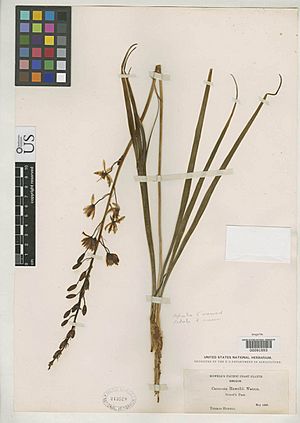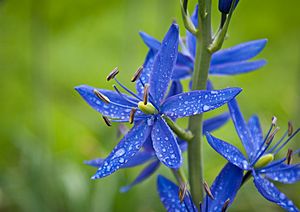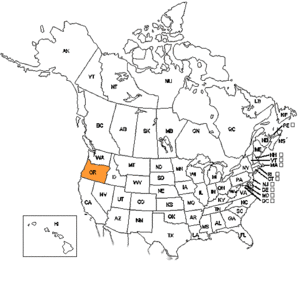Howell's camas facts for kids
Quick facts for kids Howell's camas |
|
|---|---|
 |
|
| herbarium specimen at Smithsonian collected in Oregon 1889 |
|
| Conservation status | |
| Scientific classification | |
| Genus: |
Camassia
|
| Species: |
howellii
|
| Synonyms | |
|
|
Howell's camas, also known as Camassia howellii, is a special type of plant. It grows only in western Oregon. This plant was first found in 1889. Today, Howell's camas is in danger. Its homes are being lost because of human activities.
Where Howell's Camas Grows
Howell's camas grows only in the southwestern part of Oregon. There are only about 12 groups of these plants left. Together, they make up about 3,000 plants. Their homes are threatened by things people do. This plant is considered "imperiled," which means it is in danger. While other types of Camassia plants are common, Howell's camas is not.
This plant loves wet meadows. It grows well in a special kind of soil called serpentine soil. You can find it in areas of Oregon that get a lot of rain. These areas get about 70 to 100 inches of rain each year. Temperatures there usually stay between 40 and 80 degrees Fahrenheit. Howell's camas blooms later in the spring, usually in May. Its flowers then fade away in the autumn.
What Howell's Camas Looks Like
Howell's camas grows from a bulb, which is like a small onion. It has long leaves that grow from the base of the plant. These leaves can be up to 60 centimeters (about 2 feet) long. Each plant usually has about 4 to 7 leaves.
The plant's flower stalks grow quite tall. They can reach about 15 to 40 centimeters (6 to 16 inches) long. The flowers are usually a pretty bluish-violet color. Each flower is radially symmetrical, meaning it looks the same from all sides. This is like a star or a bicycle wheel.
Each flower has five petals. These petals are about 10 to 20 millimeters long (less than an inch). They are also about 3 to 5 millimeters wide. A single flower stalk can have up to 100 flowers! These flowers sit on a stem that can be about 50 centimeters (20 inches) tall. As mentioned, these beautiful flowers typically bloom in May.
How People Used Howell's Camas
Long ago, Native Americans and early settlers used Howell's camas as an important food. The city of Camas in Washington state was even named after this plant. This shows how much it was grown and eaten by people in the Northwest.
In the autumn, after the flowers dried up, people would harvest the bulbs. They would boil them or cook them in pits in the ground. People also dried the bulbs and ground them into flour. This flour could be used to make bread or other foods. As more settlers moved into the area, they brought cattle. These cattle ate the camas plants, which limited how much the plant could grow.




